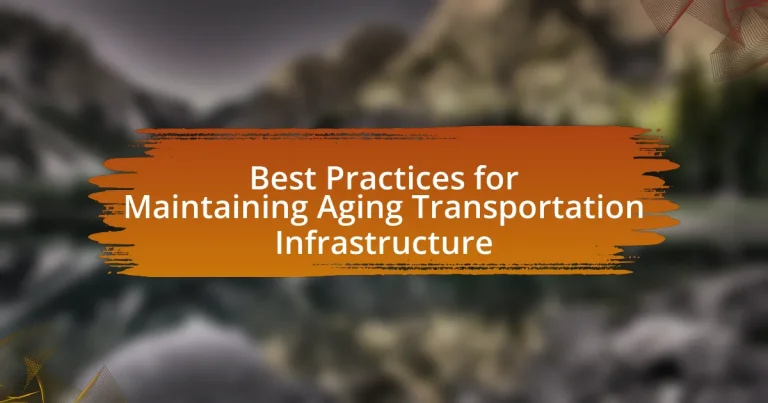The article focuses on best practices for maintaining aging transportation infrastructure, emphasizing the importance of regular inspections, timely repairs, and proactive asset management. It highlights the critical role of maintenance in ensuring public safety and economic efficiency, while also addressing the consequences of neglect, such as increased repair costs and safety hazards. Key components of effective maintenance strategies include data-driven decision-making and resource allocation, with technology playing a significant role in enhancing maintenance practices. The article also discusses the challenges faced in maintaining infrastructure, the importance of stakeholder collaboration, and the impact of community involvement on maintenance decisions.

What are the Best Practices for Maintaining Aging Transportation Infrastructure?
The best practices for maintaining aging transportation infrastructure include regular inspections, timely repairs, and proactive asset management. Regular inspections help identify structural issues early, allowing for timely repairs that can prevent further deterioration. Proactive asset management involves using data analytics to prioritize maintenance activities based on the condition and usage of infrastructure, ensuring resources are allocated efficiently. According to the American Society of Civil Engineers, investing in maintenance can save up to four times the cost of repairs if issues are addressed early, highlighting the importance of these practices in extending the lifespan of transportation assets.
Why is it important to maintain aging transportation infrastructure?
Maintaining aging transportation infrastructure is crucial for ensuring public safety and economic efficiency. Deteriorating roads, bridges, and transit systems can lead to accidents, increased vehicle wear, and higher maintenance costs. According to the American Society of Civil Engineers, the U.S. faces a $2.59 trillion investment gap in infrastructure, which highlights the urgent need for maintenance to prevent further degradation and associated risks. Regular upkeep not only extends the lifespan of these assets but also supports economic growth by facilitating reliable transportation for goods and services.
What are the consequences of neglecting maintenance?
Neglecting maintenance leads to increased deterioration of transportation infrastructure, resulting in safety hazards and higher repair costs. For instance, the American Society of Civil Engineers reported that inadequate maintenance of roads and bridges contributes to a significant rise in accidents and structural failures, costing the U.S. economy billions annually. Furthermore, neglected infrastructure can lead to service disruptions, increased travel times, and reduced public trust in transportation systems, ultimately impacting economic productivity and community well-being.
How does maintenance impact safety and efficiency?
Maintenance directly enhances safety and efficiency by ensuring that transportation infrastructure operates within designed parameters and minimizes the risk of failures. Regular maintenance activities, such as inspections and repairs, prevent deterioration and address potential hazards, which statistically reduces accidents. For instance, the Federal Highway Administration reports that well-maintained roads can decrease crash rates by up to 30%. Additionally, efficient maintenance practices optimize resource allocation, leading to reduced operational costs and improved service delivery. This correlation between maintenance, safety, and efficiency is evident in studies showing that proactive maintenance strategies can extend the lifespan of infrastructure by 20-30%, thereby enhancing overall system reliability.
What are the key components of effective maintenance strategies?
The key components of effective maintenance strategies include regular inspections, preventive maintenance, data-driven decision-making, and resource allocation. Regular inspections ensure that potential issues are identified early, reducing the risk of major failures. Preventive maintenance involves scheduled servicing to prolong the lifespan of infrastructure, which is supported by studies indicating that proactive measures can reduce overall maintenance costs by up to 30%. Data-driven decision-making utilizes analytics to prioritize maintenance tasks based on condition assessments and usage patterns, enhancing efficiency. Finally, effective resource allocation ensures that financial and human resources are optimally distributed to address the most critical maintenance needs, which is essential for maintaining aging transportation infrastructure effectively.
What role does regular inspection play in maintenance?
Regular inspection is crucial in maintenance as it identifies potential issues before they escalate into significant problems. By systematically evaluating the condition of infrastructure, maintenance teams can detect wear, corrosion, or structural weaknesses early. This proactive approach not only extends the lifespan of transportation assets but also ensures safety and reliability for users. Studies indicate that regular inspections can reduce maintenance costs by up to 30% by preventing major repairs and downtime, thereby validating the importance of consistent monitoring in maintaining aging transportation infrastructure.
How can technology enhance maintenance practices?
Technology enhances maintenance practices by enabling predictive maintenance through data analytics and IoT sensors. These technologies allow for real-time monitoring of infrastructure conditions, which helps identify potential issues before they escalate into costly repairs. For instance, a study by the Federal Highway Administration found that implementing predictive maintenance strategies can reduce maintenance costs by up to 30% and extend the lifespan of transportation assets. By utilizing advanced technologies, maintenance teams can optimize scheduling, allocate resources more effectively, and improve overall operational efficiency.
What challenges are faced in maintaining aging transportation infrastructure?
Maintaining aging transportation infrastructure presents significant challenges, primarily due to limited funding, increasing safety concerns, and the complexity of repairs. Limited funding restricts the ability to perform necessary upgrades and maintenance, leading to deteriorating conditions; for instance, the American Society of Civil Engineers reported in 2021 that the U.S. requires $2.59 trillion to improve its infrastructure. Increasing safety concerns arise as aging structures may not meet current safety standards, resulting in potential hazards for users. Additionally, the complexity of repairs often involves coordinating multiple stakeholders, including government agencies and contractors, which can complicate project timelines and increase costs.
How do budget constraints affect maintenance efforts?
Budget constraints significantly limit maintenance efforts by reducing the available funds for necessary repairs and upkeep. When financial resources are restricted, transportation agencies often prioritize immediate safety concerns over long-term maintenance, leading to deferred maintenance and increased deterioration of infrastructure. According to a report by the American Society of Civil Engineers, the U.S. faces a funding gap of approximately $2 trillion for infrastructure improvements, which exacerbates the challenges of maintaining aging transportation systems. This lack of funding results in a cycle of neglect, where insufficient maintenance leads to more costly repairs in the future, ultimately compromising safety and efficiency.
What are the common technical challenges in maintenance?
Common technical challenges in maintenance include aging infrastructure, limited funding, and outdated technology. Aging infrastructure often leads to increased wear and tear, making it difficult to maintain safety and functionality. Limited funding restricts the ability to perform necessary repairs and upgrades, resulting in deferred maintenance that exacerbates existing issues. Outdated technology can hinder efficient maintenance processes, as older systems may lack the capabilities for effective monitoring and management. These challenges are supported by studies indicating that many transportation agencies face significant budget constraints and struggle to keep pace with technological advancements, ultimately impacting the reliability of infrastructure.

How can stakeholders collaborate to improve maintenance practices?
Stakeholders can collaborate to improve maintenance practices by establishing clear communication channels and sharing data on infrastructure conditions. Effective collaboration involves regular meetings among government agencies, private contractors, and community organizations to align maintenance goals and strategies. For instance, the Federal Highway Administration emphasizes the importance of data sharing in its “Asset Management Guide,” which states that coordinated efforts lead to more efficient resource allocation and improved maintenance outcomes. By leveraging technology such as Geographic Information Systems (GIS) and predictive analytics, stakeholders can make informed decisions that enhance the longevity and safety of aging transportation infrastructure.
What roles do government agencies play in infrastructure maintenance?
Government agencies are responsible for overseeing and implementing infrastructure maintenance through planning, funding, regulation, and direct management. They develop maintenance schedules, allocate budgets, and enforce safety standards to ensure infrastructure remains functional and safe for public use. For instance, the Federal Highway Administration allocates billions in funding annually for road maintenance and improvements, demonstrating the critical financial role government agencies play. Additionally, agencies conduct inspections and assessments to identify necessary repairs, ensuring timely interventions that prolong the lifespan of infrastructure assets.
How can public-private partnerships enhance maintenance efforts?
Public-private partnerships (PPPs) can enhance maintenance efforts by leveraging the strengths of both sectors to improve efficiency and resource allocation. These collaborations allow for shared investment, where private entities bring in capital and expertise, leading to innovative maintenance solutions and reduced costs. For instance, a study by the National Cooperative Highway Research Program found that PPPs can lead to a 20% reduction in maintenance costs and improved service delivery times due to the private sector’s operational efficiencies. By combining public oversight with private sector agility, PPPs can ensure that aging transportation infrastructure is maintained more effectively and sustainably.
What is the importance of community involvement in maintenance decisions?
Community involvement in maintenance decisions is crucial as it enhances the effectiveness and sustainability of infrastructure projects. Engaging local residents allows for the identification of specific needs and priorities, ensuring that maintenance efforts align with community expectations. Research indicates that projects with community input are more likely to receive public support and funding, as seen in the case of the Federal Highway Administration’s initiatives, which emphasize stakeholder engagement to improve project outcomes. Furthermore, community involvement fosters a sense of ownership, leading to increased vigilance and care for the infrastructure, ultimately prolonging its lifespan and functionality.
How can data-driven approaches improve maintenance outcomes?
Data-driven approaches can significantly improve maintenance outcomes by enabling predictive analytics that forecast equipment failures before they occur. By analyzing historical data and real-time sensor information, maintenance teams can identify patterns and trends that indicate when a component is likely to fail. For instance, a study by the Federal Highway Administration found that implementing data analytics in maintenance planning can reduce costs by up to 30% and extend asset life by 20%. This proactive strategy allows for timely interventions, minimizing downtime and enhancing the overall reliability of transportation infrastructure.
What types of data are essential for effective maintenance planning?
Essential data for effective maintenance planning includes asset condition data, maintenance history, usage patterns, and environmental factors. Asset condition data provides insights into the current state of infrastructure, enabling prioritization of maintenance tasks. Maintenance history reveals past interventions and their outcomes, guiding future decisions. Usage patterns, such as traffic volume and load, inform the wear and tear on infrastructure, while environmental factors, including weather conditions and geographical influences, affect the longevity and performance of assets. Collectively, these data types enhance decision-making and resource allocation in maintaining aging transportation infrastructure.
How can predictive analytics be utilized in maintenance strategies?
Predictive analytics can be utilized in maintenance strategies by analyzing historical data to forecast equipment failures and optimize maintenance schedules. This approach allows organizations to transition from reactive maintenance to proactive strategies, thereby reducing downtime and maintenance costs. For instance, a study by the U.S. Department of Transportation found that predictive maintenance can reduce maintenance costs by up to 30% and extend the lifespan of infrastructure assets by identifying issues before they escalate. By leveraging machine learning algorithms and real-time data, predictive analytics enhances decision-making processes, ensuring timely interventions and improved resource allocation in maintaining aging transportation infrastructure.

What are the most effective maintenance techniques for aging infrastructure?
The most effective maintenance techniques for aging infrastructure include regular inspections, preventive maintenance, and rehabilitation strategies. Regular inspections allow for the early detection of issues, enabling timely repairs that can prevent further deterioration. Preventive maintenance, such as routine cleaning and minor repairs, helps extend the lifespan of infrastructure by addressing wear and tear before it leads to significant damage. Rehabilitation strategies, including resurfacing and structural reinforcements, restore functionality and safety to aging systems. According to the American Society of Civil Engineers, investing in these maintenance techniques can significantly reduce long-term costs and improve the reliability of transportation infrastructure.
What are the best practices for conducting inspections?
The best practices for conducting inspections of aging transportation infrastructure include thorough planning, adherence to safety protocols, and the use of advanced technology. Thorough planning ensures that inspectors are aware of the specific areas that require attention, while safety protocols protect both inspectors and the public during the inspection process. The use of advanced technology, such as drones and sensors, enhances the accuracy and efficiency of inspections by providing detailed data on structural conditions. According to the Federal Highway Administration, implementing these practices can lead to improved maintenance decisions and extended lifespan of infrastructure assets.
How often should inspections be performed on aging infrastructure?
Inspections on aging infrastructure should be performed at least annually. This frequency is recommended by the Federal Highway Administration, which emphasizes that regular inspections help identify deterioration and ensure safety. Additionally, specific conditions such as the age, type, and usage of the infrastructure may necessitate more frequent inspections, potentially every six months, to address any emerging issues promptly. Regular assessments are crucial for maintaining structural integrity and public safety.
What tools and technologies are recommended for inspections?
Recommended tools and technologies for inspections include drones, ultrasonic testing devices, and ground-penetrating radar. Drones provide aerial views and can access hard-to-reach areas, enhancing visual inspections. Ultrasonic testing devices measure material thickness and detect flaws in structures, ensuring safety and integrity. Ground-penetrating radar allows for subsurface imaging, identifying issues like voids or cracks beneath the surface. These technologies improve inspection accuracy and efficiency, which is crucial for maintaining aging transportation infrastructure.
What maintenance techniques are most effective for different types of infrastructure?
Preventive maintenance techniques are most effective for various types of infrastructure, including roads, bridges, and transit systems. For roads, regular inspections and surface treatments, such as sealcoating and crack sealing, help extend pavement life by addressing minor issues before they escalate. Bridges benefit from routine structural assessments and the application of protective coatings to prevent corrosion, which can significantly reduce repair costs and prolong service life. Transit systems, including rail and bus networks, utilize scheduled maintenance and condition monitoring to ensure reliability and safety, with techniques like predictive maintenance leveraging data analytics to anticipate failures before they occur. These methods are supported by studies indicating that proactive maintenance can reduce overall costs by up to 30% and improve infrastructure longevity.
How should road maintenance differ from bridge maintenance?
Road maintenance should differ from bridge maintenance primarily in the focus of inspection and repair techniques. Roads typically require regular surface treatments, such as sealcoating and pothole repairs, to address wear from traffic and weather, while bridges necessitate more specialized inspections for structural integrity, including checks for corrosion, fatigue, and load-bearing capacity. According to the Federal Highway Administration, bridges are subject to different stressors and deterioration mechanisms compared to roads, which justifies the need for distinct maintenance protocols tailored to their unique structural requirements.
What specific techniques are recommended for rail infrastructure?
Specific techniques recommended for rail infrastructure include regular track inspections, advanced monitoring technologies, and the use of resilient materials. Regular track inspections, conducted using automated systems, help identify wear and defects early, reducing the risk of accidents. Advanced monitoring technologies, such as sensors and drones, provide real-time data on track conditions, enabling proactive maintenance. The use of resilient materials, like high-strength concrete and steel, enhances durability and extends the lifespan of rail components. These techniques are supported by studies showing that proactive maintenance can reduce costs and improve safety in rail operations.
What are some practical tips for implementing maintenance best practices?
To implement maintenance best practices for aging transportation infrastructure, prioritize regular inspections and assessments to identify issues early. Conducting routine evaluations allows for timely repairs, which can prevent more significant problems and extend the lifespan of infrastructure. Additionally, establish a comprehensive maintenance schedule that includes preventive measures, ensuring that all components are serviced at appropriate intervals. Research indicates that proactive maintenance can reduce long-term costs by up to 30%, as it minimizes the need for extensive repairs and replacements. Furthermore, utilize data analytics to track performance and maintenance history, enabling informed decision-making and resource allocation. This approach has been shown to enhance operational efficiency and improve safety outcomes in transportation systems.


